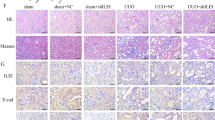Abstract
Injured renal tubular epithelial cells (RTECs) have been recently thought to directly contribute to the accumulation of myofibroblasts in renal tubulointerstitial fibrosis through a process of epithelial to mesenchymal transition (EMT). However, the factors inducing RTECs to undergo EMT and the underlying mechanisms need to be further elucidated. This study aimed to determine the EMT-inducing activity of proinflammatory cytokine TNF-α and the role for complement 3 (C3) in this activity in an in vitro model of human RTECs (HK-2 cells). Wild type HK-2 cells were treated with TNF-α, IFN-γ or C3a; C3 siRNA- or control siRNA-carrying HK-2 cells were treated with TNF-α. Changes in the cell morphology and phenotype were assessed by microscopy, RT-PCR, western blotting, and immunostaining. TNF-α effectively induced HK-2 cells to express C3 and to transform into morphologically myofibroblast-like cells that lost E-cadherin (a classical epithelial cell marker) expression but acquired alpha-smooth muscle actin (α-SMA, a classical myofibroblast differentiation marker) expression. C3 siRNA robustly attenuated all the morphologic and phenotypic changes induced by TNF-α but the control siRNA showed no effect. Our preliminary observations suggest that TNF-α may induce EMT in RTECs through inducing C3 expression.






Similar content being viewed by others
References
Strutz, F., & Zeisberg, M. (2006). Renal fibroblasts and myofibroblasts in chronic kidney disease. Journal of the American Society of Nephrology, 17, 2992–2998.
Yang, J., & Liu, Y. (2001). Dissection of key events in tubular epithelial to myofibroblast transition and its implications in renal interstitial fibrosis. American Journal of Pathology, 159, 1465–1475.
Iwano, M., Plieth, D., Danoff, T. M., Xue, C., Okada, H., & Neilson, E. G. (2002). Evidence that fibroblasts derive from epithelium during tissue fibrosis. Journal of Clinical Investigation, 110, 341–350.
Xu, Y., Wan, J., Jiang, D., & Wu, X. (2009). BMP-7 counteracts TGF-beta1-induced epithelial-to-mesenchymal transition in human renal proximal tubular epithelial cells. Journal of Nephrology, 22, 403–410.
Xu, Y., Wan, J., Jiang, D., & Wu, X. (2010). BMP-7 blocks the cyclosporine-A-induced epithelial-to-mesenchymal transition in renal tubular epithelial cells. Nephron Experimental Nephrology, 114, e23–e31.
Wu, S. T., Sun, G. H., Hsu, C. Y., Huang, C. S., Wu, Y. H., Wang, H. H., et al. (2011). Tumor necrosis factor-alpha induces epithelial-mesenchymal transition of renal cell carcinoma cells via a nuclear factor kappa B-independent mechanism. Experimental Biology and Medicine (Maywood), 236, 1022–1029.
Rangan, G. K., Pippin, J. W., & Couser, W. G. (2004). C5b-9 regulates peritubular myofibroblast accumulation in experimental focal segmental glomerulosclerosis. Kidney International, 66, 1838–1848.
Copeland, J. W., Beaumont, B. W., Merrilees, M. J., & Pilmore, H. L. (2007). Epithelial-to-mesenchymal transition of human proximal tubular epithelial cells: effects of rapamycin, mycophenolate, cyclosporin, azathioprine, and methylprednisolone. Transplantation, 83, 809–814.
Farrar, C. A., Zhou, W., Lin, T., & Sacks, S. H. (2006). Local extravascular pool of C3 is a determinant of postischemic acute renal failure. The FASEB Journal, 20, 217–226.
Pratt, J. R., Basheer, S. A., & Sacks, S. H. (2002). Local synthesis of complement component C3 regulates acute renal transplant rejection. Nature Medicine, 8, 582–587.
Turnberg, D., Lewis, M., Moss, J., Xu, Y., Botto, M., & Cook, H. T. (2006). Complement activation contributes to both glomerular and tubulointerstitial damage in adriamycin nephropathy in mice. Journal of Immunology, 177, 4094–4102.
Wan, J. X., Fukuda, N., Endo, M., Tahira, Y., Yao, E. H., Matsuda, H., et al. (2007). Complement 3 is involved in changing the phenotype of human glomerular mesangial cells. Journal of Cellular Physiology, 213, 495–501.
Lin, Z. H., Fukuda, N., Jin, X. Q., Yao, E. H., Ueno, T., Endo, M., et al. (2004). Complement 3 is involved in the synthetic phenotype and exaggerated growth of vascular smooth muscle cells from spontaneously hypertensive rats. Hypertension, 44, 42–47.
Tang, Z., Lu, B., Hatch, E., Sacks, S. H., & Sheerin, N. S. (2009). C3a mediates epithelial-to-mesenchymal transition in proteinuric nephropathy. Journal of the American Society of Nephrology, 20, 593–603.
Nangaku, M. (2004). Mechanisms of tubulointerstitial injury in the kidney: Final common pathways to end-stage renal failure. Internal Medicine, 43, 9–17.
Kalluri, R., & Neilson, E. G. (2003). Epithelial-mesenchymal transition and its implications for fibrosis. Journal of Clinical Investigation, 112, 1776–1784.
Remuzzi, G., & Bertani, T. (1998). Pathophysiology of progressive nephropathies. New England Journal of Medicine, 339, 1448–1456.
Morgan, B. P., & Gasque, P. (1997). Extrahepatic complement biosynthesis: Where, when and why? Clinical and Experimental Immunology, 107, 1–7.
Daha, M. R., & van Kooten, C. (2000). Is there a role for locally produced complement in renal disease? Nephrology, Dialysis, Transplantation, 15, 1506–1509.
Sacks, S. H., Zhou, W., Andrews, P. A., & Hartley, B. (1993). Endogenous complement C3 synthesis in immune complex nephritis. Lancet, 342, 1273–1274.
Sheerin, N. S., Risley, P., Abe, K., Tang, Z., Wong, W., Lin, T., et al. (2008). Synthesis of complement protein C3 in the kidney is an important mediator of local tissue injury. The FASEB Journal, 22, 1065–1072.
Zhou, W., Farrar, C. A., Abe, K., Pratt, J. R., Marsh, J. E., Wang, Y., et al. (2000). Predominant role for C5b-9 in renal ischemia/reperfusion injury. Journal of Clinical Investigation, 105, 1363–1371.
Suetsugu-Maki, R., Maki, N., Fox, T. P., Nakamura, K., Cowper Solari, R., Tomlinson, C. R., et al. (2011). A complement receptor C5a antagonist regulates epithelial to mesenchymal transition and crystallin expression after lens cataract surgery in mice. Molecular Vision, 17, 949–964.
Author information
Authors and Affiliations
Corresponding author
Rights and permissions
About this article
Cite this article
Wan, J., Zhou, X., Cui, J. et al. Role of Complement 3 in TNF-α-Induced Mesenchymal Transition of Renal Tubular Epithelial Cells In Vitro. Mol Biotechnol 54, 92–100 (2013). https://doi.org/10.1007/s12033-012-9547-2
Published:
Issue Date:
DOI: https://doi.org/10.1007/s12033-012-9547-2




